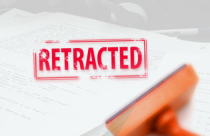Retraction Watch: Reports on Retractions of Scientific Papers

Retraction: A Sanction of Last Resort
When an academic journal formally retracts an article, it is considered one of the most serious acts that can be taken against an author or team of authors.
Such a sanction has the potential to damage the reputation of all parties concerned—the authors (whose careers may never recover), the research institution (that may face a tough time getting future funding in light of evidence of poor oversight), and the journal itself, whose peer review process is automatically brought into question.
Most Serious Means Most Hesitant
In the face of such serious consequences, many journal editors have admitted to being very hesitant to order retractions unless there is simply no other option. The Committee on Publication Ethics (COPE) offers detailed guidelines on how and when an article should be retracted, but journals are given full freedom as to whether or not to follow those guidelines.
As a result, PDF watermark notifications are only used about 40% of the time. Some journals will make a notation on their website, some will append a note to the PDF document, and others will delete the article altogether. Of greater concern, however, is that an estimated 30% of journals will make no reference to the retraction whatsoever.
Too Much Money
Such hesitation is disconcerting in the face of a rising tide of retractions. The science journal Nature estimated that the early 2000’s saw only 30 retraction notices per year, whereas by 2011, that number had risen to over 400 per year and was continuing to rise. In addition, the wording of those retractions has become increasingly non-specific to the point where it is impossible to distinguish between an error and deliberate scientific misconduct.
There is now so much money involved in academic research, especially in the revenue potential of applied research, that many retractions will prompt litigation to preserve the reputations (and future earning potential) of all involved. If journals can’t be trusted to fully disclose the details behind retractions (assuming they disclose the retraction in the first place), what other options are there?
What Is Retraction Watch? A New Watchdog!
In December 2014, the MacArthur Foundation gave $400,000 to support the expansion of a popular blog called Retraction Watch. Launched in 2010 by science writer Adam Marcus, and medical journalist and global editorial director of MedPage Today, Ivan Oransky, the blog developed from editorial coverage of retraction cases to a broader commitment to catalog retracted articles as a curation of a more systemic problem.
Chasing retractions in prestigious journals, or tracking scoreboards for the highest number of retractions for one researcher (Yoshitaka Fujii is the current record holder with 183) is merely “reality journalism.” It’s time to move beyond such fascinating numbers and disconcerting content.
Now that Retraction Watch has been awarded the MacArthur grant, it will start building a comprehensive database of these retractions that will contribute to research on some of the overarching concerns that must be addressed if the problem is to be solved.
It’s good that the academic community has accepted the existence of a rising tide of retractions. But further research is needed to see how many of those retractions reflect sloppy research, and how many reflect deliberate scientific misconduct.









